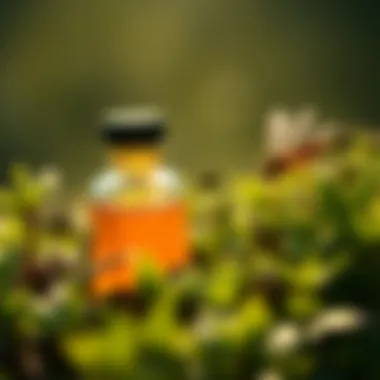Natural Insect Repellents for Healthy Plants


Intro
Gardening is often seen as a tranquil pastime, yet the constant battle against pesky insects can be a considerable challenge for avid gardeners. Insects may seem innocuous at first glance, but certain species can wreak havoc on your beloved plants if left unchecked. As the world trends towards more environmentally-friendly practices, organic insect repellents have emerged as a viable solution for gardeners seeking to preserve their plants without resorting to synthetic chemicals. This article explores the realm of organic insect repellents, shedding light on not just the methods for harnessing nature’s bountiful resources but also the broader ecological benefits of these approaches.
With pest management practices evolving, understanding the various ways to deter unwanted critters while promoting plant health is more crucial than ever. This guide will navigate through the principles of organic pest control, provide actionable recipes for homemade repellents, and discuss the plants that are most susceptible to pests. By integrating these organic solutions, you can not only protect your garden but also contribute to a healthier environment. So, let’s dig deep into the possibilities of organic insect repellents to ensure your gardening experience is as fruitful as it is sustainable.
Understanding Organic Insect Repellents
In the realm of gardening, understanding the concept of organic insect repellents is crucial for any homeowner looking to maintain a vibrant and pest-free garden. This section will shed light on organic pest control and its significance, not just for plant health but for the surrounding ecosystem as well.
Utilizing organic methods offers a dual advantage: protecting plants from harmful insects while also minimizing the risk to the environment. By opting for natural solutions, gardeners can navigate around the hazardous effects that synthetic chemicals impose, such as harming beneficial insects, contaminating soil, or posing health risks to pets and humans. Embracing organic insect repellents also nurtures a sustainable approach, weaving conservation into everyday gardening practices.
Defining Organic Pest Control
Organic pest control refers to techniques and methods that use naturally derived ingredients to manage pest populations without synthetic pesticides. This approach focuses on the principle that a healthy ecosystem can limit pest outbreaks. For instance, many gardeners rely on companion planting, which involves growing specific plants together to deter pests.
There are several types of organic pest control:
- Cultural Control: Changing farming practices (like crop rotation) to disrupt pest life cycles.
- Mechanical Control: Physical barriers such as nets to keep pests away.
- Biological Control: Introducing natural predators (like ladybugs for aphid control) into the environment.
These methods promote biodiversity and support the natural resistance of plants, which ultimately contributes to a more harmonized garden ecosystem.
The Chemistry Behind Organic Insecticides
Understanding the chemistry of organic insecticides can seem daunting at first, but at its core is the use of plant-based substances that have insect-repellent properties. For instance, compounds such as pyrethrin, derived from chrysanthemum flowers, disrupt the nervous systems of pests without affecting humans or pets significantly. Other substances, such as neem oil, derived from the Indian neem tree, work by disrupting the life cycle of insects, effectively preventing them from feeding and reproducing.
Many of these organic insecticides break down more quickly in the environment than synthetic ones, reducing residual effects. Consequently, they can be used with less concern over environmental persistence, making them a sensible choice for conscientious gardeners.
Comparing Organic and Synthetic Options
When tackling pest issues, gardeners often weigh their options between organic and synthetic repellents. While synthetic products can provide instant results, they may carry various drawbacks. Increased reliance on these chemicals can lead to pesticide resistance in pests, meaning more potent solutions are necessary over time.
Considerations in the comparison include:
- Efficacy: Organic solutions may require more frequent applications but can be just as effective when used correctly.
- Safety: Organic options are generally safer for humans and pets, whereas synthetic pesticides can pose health risks.
- Environmental Impact: Organic repellents positively influence the garden ecosystem and help improve soil health, aiding sustainable practices.
As gardeners continue to seek alternatives that align with their values and principles, understanding the nuances of organic insect repellents becomes essential for fostering both a healthy garden and environment.
"Embracing organic practices not only keeps your plants safe but also supports the broader health of our planet's ecosystems."
In essence, recognizing the various facets of organic insect repellents arms gardeners with knowledge they can rely on to cultivate healthier, thriving gardens.
Benefits of Organic Insect Repellents
Organic insect repellents have become an essential aspect of sustainable gardening. As homeowners and gardening aficionados increasingly seek ways to protect their plants without the adverse effects of synthetic chemicals, understanding the benefits of organic solutions is critical. These repellents not only foster a harmonious relationship with nature but also ensure the safety of your loved ones and the environment. Let us delve into the specific advantages that organic insect repellents offer.
Safety for Human and Pet Exposure
One of the primary concerns for anyone using pest control methods revolves around the safety of household members, including pets. Organic insect repellents, derived from natural ingredients, pose significantly less risk when compared to their synthetic counterparts. A common myth is that natural equates to ineffective, yet this isn’t the case.
Here are some benefits related to safety:
- Non-Toxic Ingredients: Most organic repellents utilize substances like essential oils, garlic, or neem oil, all of which are generally safe for humans and pets.
- Lower Risk of Allergic Reactions: Unlike powerful synthetic chemicals that can irritate skin or cause respiratory issues, organic options typically don’t trigger allergic reactions.
- Safe to Use in Food Gardens: Certain organic repellents can be safely used on vegetables and herbs, providing peace of mind when it comes to food safety.
"Using organic methods means you don’t just protect your plants, but you also care for the well-being of your family. It’s a win-win."
Minimizing Environmental Impact
Another significant advantage of organic insect repellents is their minimal impact on the environment. With growing concerns over ecological sustainability, opting for organic methods is a thoughtful and responsible choice.
How do organic repellents achieve this?
- Biodiversity Support: Organic practices help maintain biodiversity in ecosystems. By avoiding synthetic pesticides, beneficial insects like bees and ladybugs remain unharmed, allowing them to thrive.
- No Chemical Residue: Traditional pesticides can seep into water sources, affecting aquatic life. Organic repellents typically break down naturally, leaving behind little to no chemical residue.
- Soil Health: Chemical-based repellents can degrade soil quality over time. Organic alternatives, on the other hand, promote a healthier soil microbiome, fostering robust plant growth.
Enhancing Plant Health and Soil Quality


Lastly, organic insect repellents not only protect plants but also enhance their overall health. This is particularly relevant for those passionate about nurturing their gardens.
Consider the following benefits:
- Boosted Plant Resilience: Plants treated with organic repellents often develop stronger natural defenses, making them less susceptible to pest damage over time.
- Nutrient-Rich Soil: Many organic repellents are made from compostable materials that can nourish the soil as they decompose, thus addressing both pest management and soil quality.
- Holistic Approach: Organic methods advocate for a more holistic gardening approach, effectively combining pest control with practices that enhance the overall ecosystem.
In summary, understanding the benefits of organic insect repellents informs better gardening practices. From ensuring safety for your family and pets to making eco-conscious decisions that promote plant health, organic solutions weave themselves into the foundation of sustainable gardening.
Common Organic Insect Repellent Methods
When it comes to maintaining a healthy garden, employing organic insect repellent methods stands out as a vital strategy. Not only do these methods safeguard your plants from a wide range of pests, but they also promote environmental sustainability. By opting for natural solutions, gardeners can reduce their reliance on synthetic chemicals, which often wreak havoc on beneficial insects and soil health.
In this section, we will explore various techniques for creating organic insect repellents, such as the use of essential oils, natural mixtures including garlic and chili peppers, companion plant strategies, and homemade spray recipes. Getting to grips with these approaches can help you effectively manage pest populations without compromising the ecosystem.
Essential Oils as Natural Repellents
Types of Essential Oils
Essential oils are derived from plants and have been shown to possess insect-repellent qualities. Commonly used oils include peppermint, lavender, tea tree, and eucalyptus, each having its own unique scent and properties. The key characteristic of these oils is their strong aroma, which serves to repel insects. This makes them a popular choice for those interested in organic gardening.
For example, peppermint oil not only smells refreshing to humans but is also a potent repellent against ants, spiders, and aphids. Conversely, tea tree oil has antifungal properties and can help maintain plant health while deterring pests. One advantage of essential oils is their versatility; they can be used in different applications, from sprays to topical treatments. The downside, however, is that these oils may require frequent reapplication to maintain effectiveness, especially after rain.
Application Techniques
The application techniques for essential oils are crucial for achieving the best results. Many gardeners prefer to mix a small amount of essential oil with a carrier substance, like water or vegetable oil, before applying it directly onto plants or around the garden perimeter. This method not only enhances the potency of the oils but also reduces any potential harm to the plants themselves.
Spraying your mixture early in the morning or late in the afternoon ensures the oils penetrate plants efficiently without being washed away by rain or evaporated by the sun. One unique feature of this method is that it can be easily customized based on the specific pests you're targeting. However, it requires careful measuring to avoid harming delicate plants or beneficial insects since high concentrations can sometimes prove too intense.
Garlic and Chili Peppers: A Proven Combination
Preparation of the Mixture
Garlic and chili peppers provide a powerful organic option for pest control. Together, they create a spicy concoction that many insects find unpalatable. The preparation process involves chopping garlic and chili peppers, then blending them with water and letting the mixture steep for several hours. This allows the potent properties of both ingredients to infuse into the liquid.
What sets this mixture apart is its strong scent and flavor that deters insects, making it a favorite among gardeners. It’s an inexpensive solution that often yields impressive results, especially against common garden pests like aphids and caterpillars. Nevertheless, caution is warranted as the strong smell can be off-putting to nearby pollinators as well.
Usage Guidelines
When using a garlic and chili repellent, it’s best to apply it in the early morning or late afternoon to coordinate with plant activity cycles. Use a fine spray for even coverage, especially on the undersides of leaves where pests often hide. One of the unique characteristics of this method is its eco-friendliness, as both ingredients are commonly found in most kitchens. On the flip side, frequent applications may be necessary, particularly after rain or watering sessions, to ensure continued effectiveness.
Plant-Based Solutions: Using Companion Plants
Choosing the Right Plants
Companion planting is an excellent organic method to outsmart pests by strategically placing plants together that naturally repel each other’s adversaries. For instance, marigolds are known for deterring nematodes and aphids, while basil can repel flies and mosquitoes. The key characteristic of this approach is the intrinsic relationships that help create a balanced ecosystem in your garden.
Choosing the right companion plants can significantly enhance your garden's resilience against pests. Furthermore, they not only provide pest control but can also improve plant health, boost growth, and enhance flavors. However, you must ensure compatibility between companion plants; improperly paired species might not yield the desired effects and can sometimes inhibit growth.
Placement Strategies
Placement is equally crucial when utilizing companion plants. For example, positioning marigolds near vegetable plots can deter pests while also attracting pollinators. The unique feature of this strategy is its long-term benefits – it encourages biodiversity and creates a harmonious environment.
In addition, using taller plants as natural screens can shield more vulnerable species from pests and harsh weather. That said, certain plants may require more sunlight or space, so diligent planning is a necessity.
Homemade Spray Recipes
Soap-Based Mixtures
Soap-based mixtures serve as an effective organic solution against various pests, such as aphids and spider mites. The preparation involves mixing mild soap, like Castile soap, with water before applying it directly to afflicted plants. What makes this method advantageous is its relatively low cost and simplicity.
One notable feature of soap sprays is their ability to suffocate pests without harming the plants. However, gardeners should be cautious about using soaps with added fragrances or chemicals, as they may harm beneficial insects and plants if not properly diluted.
Neem Oil Solutions
Another remarkable homemade recipe is neem oil, extracted from the seeds of the neem tree. Its active ingredients disrupt the life cycle of pests by affecting their feeding and mating behaviors. One of the critical aspects of neem oil is its broad-spectrum effectiveness, targeting many pests while being safe for beneficial organisms when used correctly.
While neem oil's unique properties make it a staple in organic gardening, it can sometimes be less effective in colder weather. And if applied too liberally, it may lead to leaf burn in sensitive plants, necessitating thoughtful application strategies.


Fermented Plant Juices
Fermented plant juices, made from the natural decaying processes of specific plants, provide an exceptionally nutrient-rich solution to bolster plant defenses against pests. By incorporating plant materials like comfrey or horsetail and allowing them to ferment, gardeners can create potent pest deterrents.
The unique characteristic of these juices is their high nutrient content, which not only aids pest control but also enhances plant vigour. However, this method does require some patience and careful handling, as poorly fermented juices can attract unwanted pests rather than deter them.
In sum, understanding and applying these common organic insect repellent methods not only aids in effective pest management but also aligns with sustainable gardening practices. With each method's distinct features, there’s an organic solution for various garden dilemmas.
Identifying Pest Problems in the Garden
Understanding how to recognize pest problems in your garden is crucial for every gardener. Being able to spot pest infestations early can be the difference between saving your plants and losing them altogether. When you know what to look for, you can take timely action and implement organic pest control methods effectively.
Common Garden Pests and Their Impact
Aphids and Their Infestation
Aphids are small insects, often found in clusters on the leaves and stems of plants. Their primary feeding method involves piercing plant tissue and sucking out the sap, which can lead to wilting, stunted growth, and even death if left unchecked. What makes aphids particularly troubling is their ability to reproduce rapidly; a single female can produce dozens of offspring in just a few days.
Another notable aspect of aphids is their relationship with ants. Ants often farm aphids for their honeydew, leading to an increase in aphid populations. This relationship complicates pest management efforts, as removing one pest group can inadvertently enhance the other. In the context of this article, understanding the dynamics of aphid populations and their impact on plant health can guide effective use of organic repellents.
Caterpillar Damage Assessment
Caterpillars, the larval stage of moths and butterflies, can wreak havoc on gardens. Identifying caterpillar damage involves looking for chewed leaves, defoliation, and visible larvae on the plants. Their voracious appetite can lead to significant plant loss in a short amount of time. One standout feature of caterpillars is their potential to become pests of varying degrees; some are harmless to plants, while others can lead to substantial economic loss in agricultural settings.
Assessing caterpillar damage enables gardeners to implement strategic pest control measures, particularly organic methods. By understanding the life cycle of these pests, you can better time your interventions, aligning them with natural pest cycles. Taking proactive steps can not only protect your plants but also maintain the ecological balance in your garden.
Signs of Pest Infestation
Recognizing signs of pest infestation early can be incredibly helpful in managing them efficiently. Look for:
- Discoloration of leaves: Yellowing, browning, or spotting can indicate pest presence.
- Sticky residue: This could be honeydew from aphids or the webbing left by spider mites.
- Unusual droppings: Leftover frass can be a telltale sign of caterpillar activity.
- Visible pests: If you see insects on your plants, it's time to take action.
By paying attention to these signs, you can act swiftly, making informed decisions about which organic repellents may be necessary.
Application Techniques for Organic Repellents
In the realm of organic gardening, knowing how to effectively use insect repellents on plants is crucial. Application techniques determine not just the effectiveness of the product but also the overall health of your plants. Understanding these methods helps in creating an environment that discourages pests while fostering strong plant growth. Proper application can mean the difference between a thriving garden and one that’s preyed upon by unwelcome guests.
Optimal Times for Application
Timing plays a pertinent role when applying organic insect repellents. It’s not just about when to spray, but also about what the weather is like. Morning tends to be the best time, as the dew has evaporated but the sun isn’t too harsh yet. This approach allows the repellent to settle on the leaves without the risk of evaporation or quick degradation due to direct sunlight.
Key points to remember when timing your applications include:
- Check weather conditions: Avoid spraying right before rain, as the repellent may wash off.
- Consider plant growth cycles: For example, young plants may be more susceptible, so protective measures should be applied sooner.
- Observe pest activity: Applying repellent at the first sign of infestation can prevent a larger problem down the line.
Spraying Methods and Best Practices
The efficacy of organic insect repellents often hinges on how they are applied. Different methods can yield varying results, and understanding these can enhance overall effectiveness.
Targeting Specific Areas
When you focus on targeted areas rather than indiscriminately spraying, it greatly increases the chances of success. This method entails identifying hotspots where pests are likely to gather, such as undersides of leaves or the stems where they might infiltrate.
The unique feature of targeting specific areas is that it reduces waste and ensures that every drop of your homemade solution counts. It allows for precision, particularly for persistent pests like aphids or spider mites. Not only does this save materials, but it also minimizes any potential harm to beneficial insects.
- Key Benefits:
- Reduced chemical usage
- Minimization of impact on beneficial insects
- Enhanced focus on areas requiring immediate attention
Frequency of Application
Another significant aspect to consider is the frequency of application. Organic repellents often require more frequent applications compared to their synthetic counterparts. This is especially true if the products are made from natural ingredients.
The unique feature of maintaining a consistent application schedule helps to build a protective barrier around your plants. This aspect not only keeps pests at bay but also reinforces the effectiveness of the organic compounds in the repellents.


- Key Considerations for Frequency:
- Older plants may require more frequent applications, particularly in peak growing seasons.
- After rainfall, reapplication tends to be necessary to maintain the protective layer.
- Observing pest activity will also dictate how often you'll need to apply. If pests seem to be hanging around, a strategic increase in frequency might be the ticket to controlling them.
Incorporating thoughtful application techniques can make a significant difference in achieving a peaceful garden. These methods help craft a tailored approach to pest management, allowing each gardener to find what works best for their unique environment.
"An ounce of prevention is worth a pound of cure." Using effective application techniques not only saves time and effort but also promotes a healthier ecosystem in your garden.
Challenges and Limitations of Organic Repellents
The realm of organic pest control can be rather exhilarating, but with its many opportunities come hurdles. It’s crucial to understand that organic insect repellents, while beneficial, come with certain limitations that may not suit every gardener's needs or situations. This section aims to shed light on the challenges encountered when using organic repellents, emphasizing their particularities, pros and cons, and giving you a candid view of what to expect if you embark on this path.
Effectiveness Against Severe Infestations
When faced with a full-blown pest invasion, organic methods often lag behind their synthetic counterparts. The strength of chemical insecticides lies in their potency; they often provide a swift resolution to severe infestations. On the contrary, organic repellents tend to work slower. For instance, while neem oil can deter and manage mild aphid populations, it may fall short when aphids have established steadfast colonies on your prized roses. In such cases, multiple applications may be necessary, which can exhaust any gardener's patience.
Furthermore, some pests have developed resistance to common organic solutions over time. This poses a challenge; the so-called natural habitats can sometimes nurture pests more effectively than expected. Utilizing organic methods becomes a balancing act, especially when your plants are fighting for survival.
"Insect control requires a careful evaluation of methods. Sometimes, even nature’s solutions need a little backup when things get tough."
Temperature and Weather Considerations
The effectiveness of organic insect repellents can be considerably influenced by environmental conditions. High humidity and warmth can amplify the efficiency of certain natural solutions, yet conversely, there are limitations when temperatures soar or chill.
Take essential oils, for example. While peppermint oil may thrive in cooler, humid climates, the efficacy can take a nosedive in blazing hot weather. Sunlight also matters; prolonged exposure can degrade these organic compounds, making their application less effective. It’s a tricky business where timing and location are paramount; a minute too early or too late, and you might miss the prime window of opportunity for an effective deterrent.
Potential Drawbacks of Repeated Use
While the benefits of organic solutions are plenty, they are not without their caveats. Continuous use of the same organic repellent can lead to diminished efficacy. Pests can adapt and even develop resilience against frequently used substances. It’s the law of nature—if they find a way to thrive, they will.
Moreover, overapplication can adversely affect your plants. Some natural ingredients, if used in excess, might disturb soil health, hinder beneficial insects, or cause plant stress. It's critical to maintain balance and rotate different repellents to minimize the risks.
To sum things up, while organic insect repellents are invaluable allies for any gardener, understanding their challenges and limitations is vital in the pursuit of a healthy garden. By approaching pest control strategically and with foresight, you equip yourself with the knowledge necessary for safeguarding your green space.
Future of Organic Pest Control
Innovation and adaptation are crucial when it comes to future-proofing our gardens against pests while remaining committed to organic practices. As the world faces challenges like climate change and biodiversity loss, the gardening community must pivot towards regenerative methods. Understanding these upcoming trends and the advances in organic pest control can inspire new levels of gardening success.
Innovation in Organic Solutions
The future of organic pest control is ripe for innovation, driven by a growing need for eco-friendly solutions. Advancements in technology and science are paving the way for new organic insect control methods that remain effective without harming the ecosystem. Here are some fresh ideas and trends to consider:
- Biocontrol Agents: One exciting avenue involves the use of predatory insects and microorganisms as natural pest control agents. For example, ladybugs can be released to tackle aphid populations efficiently, maintaining a balance that synthetic chemicals disrupt.
- Fermentation Technique: Farmers are beginning to harness fermentation to create potent organic insect repellents. This method amplifies the natural defenses found in plants, producing sprays that are both biodegradable and effective against pests.
- Smart Gardening Tech: Employing sensor technology to monitor garden conditions is on the rise. Smart devices can help identify pest hotspots, enabling targeted organic treatment when it’s most needed, reducing waste and maximizing the efficacy of the sprays used.
*"The migration towards organic pest control mirrors our increasing awareness of environmental sustainability. It’s not just about plants; it’s about the entire ecosystem."
Importance of Research and Development
Pushing the envelope in organic pest control heavily relies on diligent research and development. New methods and formulations are crucial for broadening the scope of organic pest management. Several elements highlight the importance of R&D in this domain:
- Understanding Pests: Continued research gives us better insights into pest behaviors and life cycles. This understanding directs development toward targeted solutions, enhancing the effectiveness of organic options.
- Yield Performance: Studies assessing the impact of organic methods on crop yield are critical. The better these practices perform in tests, the more likely they will be adopted by everyday gardeners and commercial farmers alike.
- Synergistic Effects: Many plant-derived repellents, when combined, can produce synergistic effects, leading to more potent solutions. Research into these combinations can yield breakthroughs in pest control.
- Regulatory Support: Innovation in organic pest control can only flourish in a supportive regulatory environment. Ongoing research backs the establishment of standards for organic products, fostering adoption while ensuring safety for consumers and the environment.
Without a doubt, investing in future innovations and supporting ongoing research in organic pest control strategies is paramount. Embracing these practices is not just about keeping our gardens healthy; it's about nurturing a more sustainable world.
End: Embracing Organic Practices
In recent years, the move towards organic gardening has solidified its roots among homeowners and gardening enthusiasts. Embracing organic practices, particularly regarding pest control, not only enhances the safety and sustainability of our gardens but also promotes a healthier ecosystem. By choosing organic insect repellents, gardeners invest in methods that work harmoniously with nature rather than against it.
Summarizing Key Points
This comprehensive guide has discussed several key aspects of organic insect repellents:
- Understanding Organic Insect Repellents: The article began by defining what organic pest control is and how it differs from synthetic options. This distinction underscores the importance of using substances that are less harmful to both the environment and ourselves.
- Benefits of Organic Options: The safety for human and pet exposure, along with less environmental impact, highlighted the various advantages that organic repellents offer. Beyond mere protection, they also contribute to enhancing plant health and soil quality.
- Common Methods: A variety of methods, including the use of essential oils, garlic, and companion planting, provide practical tools for gardeners looking to fend off pests organically.
- Application Techniques: Understanding the optimal times to apply these repellents and employing best practices ensures that gardeners achieve effective results.
- Challenges: Despite their many benefits, there are challenges to consider, including the effectiveness against severe infestations and the potential drawbacks of repeated use. This balanced view allows readers to approach organic pest management with a realistic mindset.
"Transitioning to organic gardening is not just a trend; it's a movement towards sustainable living. Every action counts, and embracing organic practices is a step in the right direction."
Call to Action for Sustainable Gardening
As we stand at the crossroads of modern gardening and traditional practices, it's time for gardeners to take the plunge into organic solutions. Consider the following actions:
- Experiment with DIY Recipes: Get your hands dirty by trying out homemade insect repellent recipes. This not only gives you control over what's applied to your plants but also makes gardening a more engaging experience.
- Incorporate Companion Plants: Identify plants that naturally repel pests and can coexist beside your favorite flowers or vegetables. This simple step can bolster your garden's defenses while maintaining aesthetic value.
- Spread the Word: Educate friends and family about the benefits of organic gardening. Knowledge shared can lead to collective action, enhancing the community's approach to sustainable gardening.
- Stay Informed and Adapt: Keep abreast of research in organic pest control. Innovation is continuously evolving, and new solutions might just be around the corner.
In summary, embracing organic practices in pest management is more than a gardening choice; it is a commitment to environmental stewardship. By nurturing our gardens with organic methods, we contribute to a healthier, balanced ecosystem, ensuring that both our plants and the planet thrive. This is not just a fleeting trend; it is a vital shift towards ecological sustainability.







